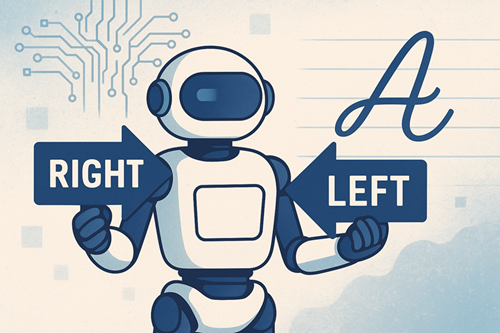Prepared for Computer Technologies, LLC
Why AI Gets Confused with “Right” and “Left” — and Why Cursive Still Matters
Introduction
Artificial Intelligence (AI) is transforming businesses at a rapid pace. From automating customer chatbots to processing handwritten forms, AI promises speed and scale. However, two often‑overlooked limitations deserve attention:
1. AI’s struggle with right/left discrimination and orientation errors.
2. AI’s persistent difficulty with cursive handwriting recognition and generation.
For businesses that rely on accuracy, customer trust, legal compliance, or document processing, understanding these limitations is essential. Let’s explore why they happen, how businesses can be affected, and what to do to prevent confusion or costly errors.
AI and Right/Left Confusion
Why it happens
– Humans naturally recognize left/right using spatial awareness and context, but AI relies strictly on data inputs. When orientation metadata is incorrect or missing, AI models may misinterpret left/right positions.
– Training data inconsistencies—such as mirrored or flipped images—cause models to generalize incorrectly.
– AI lacks human‑like spatial reasoning, making it difficult for models to interpret “your left” vs. “my left” or mirrored perspectives.
– Studies show even humans make left/right errors under pressure, and AI inherits this complexity when models are trained on imperfect or ambiguous data.
Business impact
– Healthcare: Incorrect left/right classification in images or documents risks medical errors and compliance issues.
– Logistics: Misinterpreting “left shelf” vs. “right shelf” can cause inventory errors or incorrect routing.
– Digital interfaces: Voice assistants or chatbots may misguide users, leading to frustration or mistrust.
– Marketing and creative generation: AI‑produced visuals may show gestures or directions reversed, damaging credibility.
How to prevent errors
– Validate all left/right metadata before training or deploying models.
– Use mirrored data augmentation so AI sees both perspectives.
– Standardize instructions—use “your left/right” for user‑based models and “system left/right” internally.
– Add human‑in‑the‑loop verification for orientation‑critical workflows.
AI and the Challenge of Cursive Handwriting
Why it happens
– Cursive handwriting connects letters fluidly, which makes segmentation––and therefore recognition––difficult for AI, a problem known as Sayre’s Paradox.
– Significant variation exists across handwriting styles, slant, loops, and speed, reducing recognition accuracy.
– Most AI handwriting datasets focus on print, not cursive, reducing model exposure and accuracy.
– AI struggles to generate natural cursive because stroke variations and character connections require fine‑grained motor pattern simulation.
Business impact
– Document processing: Handwritten forms, signatures, and legacy documents often fail automated OCR, requiring manual correction.
– Customer service: AI may misread cursive input from uploaded forms, causing delays or incorrect account actions.
– Legal and compliance: Misinterpreted cursive handwriting can lead to transcription errors, audit issues, or lost records.
– Branding: AI‑generated cursive signatures or notes may look unnatural, hurting authenticity.
How to prevent cursive‑related issues
– Encourage printing handwriting on customer forms.
– Train models with diverse cursive datasets if your industry relies heavily on handwritten documents.
– Always flag low‑confidence AI outputs for human review.
– Use hybrid automation workflows combining OCR + human verification.
Conclusion
AI offers powerful capabilities, but its limitations—particularly with spatial reasoning and cursive handwriting—highlight the need for thoughtful oversight. Businesses that rely heavily on accuracy, documentation, and customer trust should pair AI solutions with data validation, clear workflows, and human review to prevent costly mistakes.
References
– CheckPoint News – “The Death of Cursive”: https://www.checkpointnews.org/cursive-disappear/
– Deakin University – “Five Reasons Children Still Need to Learn Handwriting”: https://this.deakin.edu.au/society/five-reasons-children-still-need-to-learn-handwriting/
– JMIR – “Left‑Right Discrimination and Laterality Errors in AI”: https://formative.jmir.org/2025/1/e76384
– MDU Journal – “Left‑Right Discrimination and Laterality Errors”: https://mdujournal.themdu.com/issue-archive/summer-2024/left-right-discrimination-and-laterality-errors
– AIMultiple – “Handwriting Recognition Benchmark: LLMs vs OCRs”: https://research.aimultiple.com/handwriting-recognition/
– UiPath – “Enhanced Document Processing & Handwriting Recognition”: https://www.uipath.com/blog/product-and-updates/enhanced-document-processing-robots-understand-handwriting
– Wikipedia – “Sayre’s Paradox”: https://en.wikipedia.org/wiki/Sayre%27s_paradox

